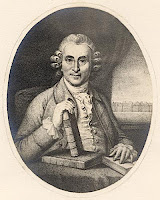Book of the Month; James Lind, A Treatise on the Scurvy

Scurvy is a disease caused by the lack of Vitamin C. This ultimate cause was not known until as recently as 1932 when Vitamin C was first isolated but the disease had been known for centuries and was particularly common on long sea voyages. With no known cure or preventative, it was one of the limiting factors of marine travel. A three-year naval expedition commanded by Commodore George Anson in the 1740s lost 1,400 out of 2,000 men. Just four were killed by enemy action. Virtually all the rest succumbed to scurvy. This rate of loss was not exceptional.
The beneficial effects of eating fresh food, particularly citrus fruit, had been noted by various individuals since the time of Hippocrates but the theory was not fully tested until a Scottish physician, James Lind, decided to experiment.
 James Lind
James Lind (1716-1794) qualified in medicine in Edinburgh, before entering the British Navy as a surgeon's mate in 1739, he was promoted to surgeon in 1747. In that same year he carried out an experiment on curing scurvy while serving on board HMS Salisbury. In the first controlled clinical trial on record, Lind selected 12 sailors suffering from scurvy, divided them into pairs and gave each pair a different dietary supplement – cider, vinegar, seawater, garlic, oranges and lemon and other foods. The patients who received the citrus fruits showed the most rapid and visible improvements. Lind published his findings in
A treatise on the scurvy in 1753. The book was widely read and ran to three editions. Dun's Library holds a copy of the third edition, published in 1772.
Despite the results of his trial, Lind was not completely convinced that fresh fruit alone could prevent scurvy and his doubts were shared by the Navy whose medical top brass could not believe that such a fatal disease could be prevented just by eating an orange each day.
Lind's work was noted with interest by the distinguished Irish doctor, David MacBride, who published, in 1767, a pamphlet entitled An historical account of a new method of treating the scurvy at sea (also in the College Library). MacBride agreed with Lind's Findings but recommended that "infusion of malt" (called wort) would have the same effect as citrus fruit but would be cheaper and could be preserved more easily.
Following the success of Captain Cook's voyage from 1768 – 1771 in which he carried a range of antiscorbutics and did not lose a single man to scurvy, the Navy finally accepted Lind's conclusions. In 1795, the year after his death, the order was issued for the regular use of lime or lemon juice throughout the Navy. Lime juice was less effective than lemon but was cheaper and so was used much more widely giving rise to the nickname "Limeys" applied by Americans to British sailors and then to British people in general. The move was, however, very successful and scurvy promptly vanished from the Royal Navy.
Robert Mills, Librarian